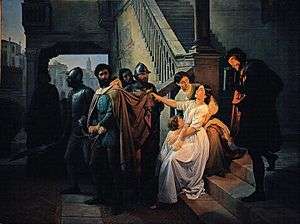Pompeo Marino Molmenti

Pompeo Marino Molmenti (Villanova in Motta di Livenza, November 8, 1819 – Venice, December 17, 1894) was an Italian painter.
Biography
He was born in the Friuli to an engineer father, Francesco, of comfortable means, Francesco, who had followed his older brother, Ettore, to Venice. When he orphaned as a boy, Pompeo was cared by uncle Ettore, who encouraged his studies. In 1834, he was enrolled in the Accademia to study under Ludovico Lipparini, Odorico Politi, and Michelangelo Grigoletti. As a student he painted Murder of Caesar.
One of his early patrons was Count Spiridione Papadopoli and his wife, Teresa Mosconi, who owned a villa in Villanova, not far from the birthplace of Molmenti. As a young man, he painted a Death of Othello for the Papadopoli family. A second version was completed in 1866.[1][2][3] During 1835 to 1840, Molmenti painted a Madonna and child for a lunette at the private oratory of the Papadopoli family, which recalled the Renaissance Madonna Giovanelli of Giovanni Bellini. He painted a Santa Teresa (now lost) for the countess, and a San Paolo (destroyed) for the church of San Polo di Piave.

From 1843 to 1844, he accompanied the Duke Saverio di Blancas in a trip through Syria and Greece. During this time he drew many Arab subjects, and painted The Departure of Tobias with Rachel from the House of Laban for his patron Papadopoli and Sara gives Agar as wife to Abraham. He then traveled to Florence, Rome, Paris, and Munich. During 1848-1849, he participated in some of the patriotic uprisings.[4]
In 1850, he displayed three paintings: Cimabue discovers in Giotto the Genius of Painting (now lost), a Holy Family copied from the Raphael painting Madonna della seggiola, and a Virgin and child and a St Ursula for the church of Sant'Orsola of Conegliano, now displayed in the duomo. He painted an Immaculate Conception for Malo near Vicenza; a Martrydom of Santa Filomena for Vidor; a San Rocco for a church of Palmanova; and Jesus gives the key to St Peter for Fontanelle.[5]
In 1851, he became professor at the Academy of Fine Arts, Venice; and worked alongside Pietro Selvatico to reform the institution. Among his pupils were Giacomo Favretto, Luigi Nono, Bressanesi, Luigi Pastega, Egisto Lancerotto, Tranquillo Cremona, Napoleone Nani, Silvio Rotta and Ettore Tito.[6] He was knighted for the Order of the Crown of Italy.[7]
In 1853 he exhibited a painting on the subject of Pia de' Tolomei, commissioned by Count Giacomo Franco and now in the Civic Museum of Verona. He also painted a Arrest of Filippo Calendario (1854) commissioned by Princess Giovanelli.[8]
References
- ↑ The latter Death of Otello now in Ca’ Pesaro museum.
- ↑ Ca' Pesaro short biography
- ↑ La Vita Italiana, Volume 2, Obituary on Pompeo Marino Molmenti, February–April 1895, Edited by Angelo de Gubernatis, page 128.
- ↑ La Vita Italiana, page 127.
- ↑ Dizionario degli artisti italiani viventi, pittori, scultori e architetti by Angelo de Gubernatis. page 305.
- ↑ La Vita Italiana, Volume 2, page 126 and 131.
- ↑ Dizionario, Gubernatis, page 305.
- ↑ La Vita Italiana, page 129.
Further reading
- Cesare Augusto Levi, Il pittore veneziano: Pompeo Marino Molmenti (1819-1894), Tipografia dell'Unione Cooperativa Editrice, 1895
External links
![]() Media related to Pompeo Marino Molmenti at Wikimedia Commons
Media related to Pompeo Marino Molmenti at Wikimedia Commons